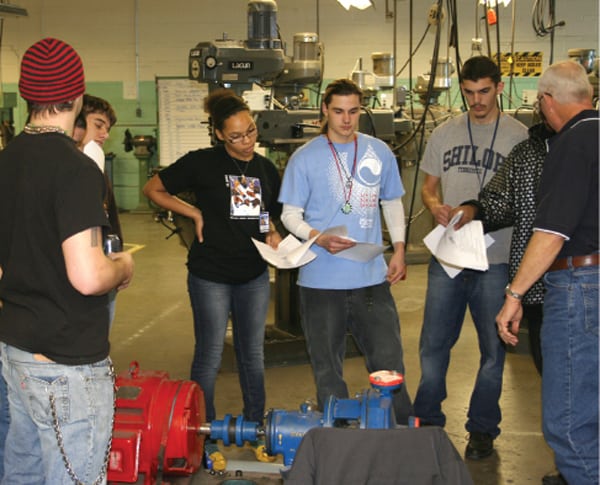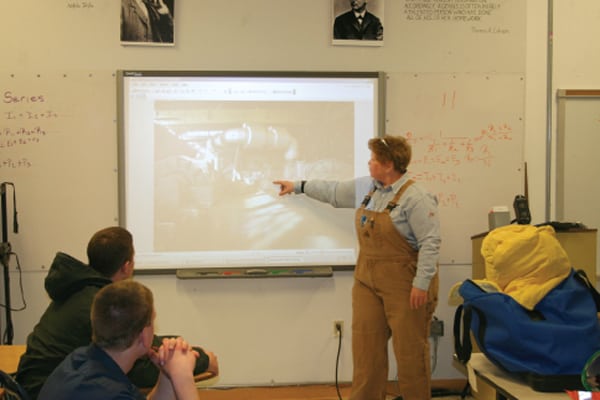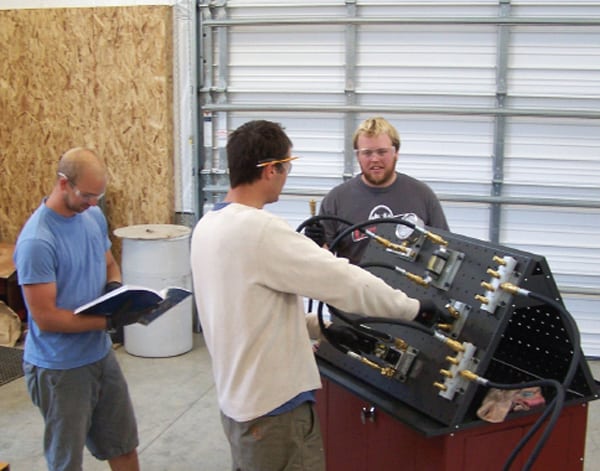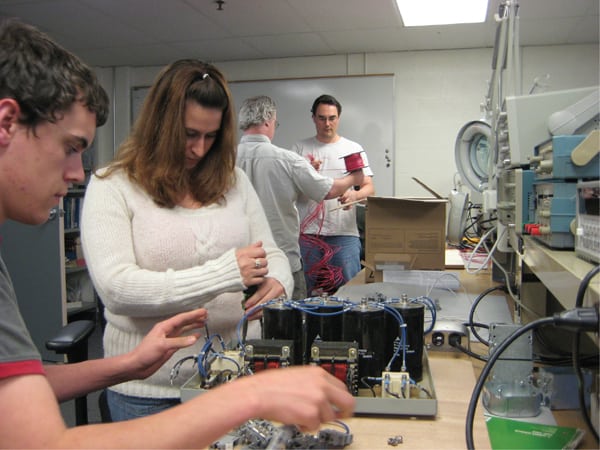Training Tomorrow’s Power Industry Workers
As U.S. electric utilities watch increasing numbers of older workers leave the workforce, they are left with a shrinking pool of experienced personnel. To meet this growing challenge, a number of educational programs are being offered to help younger workers take advantage of career opportunities in the electric power industry.
From entry-level power plant operators to senior management, the U.S. electric power industry is beginning to see major attrition through retirement. For example, the “2009 Gaps in the Energy Workforce Pipeline Survey,” prepared by the Center for Energy Workforce Development (CEWD), focuses on electric and natural gas utilities. It predicts that by 2015, 46% of the existing skilled technician workforce and 51% of the engineering workforce may need to be replaced due to potential retirement or attrition.
As POWER pointed out in an earlier article, “Generation Next: Strategies for Recruiting Younger Workers” (July 2008, accessible from our online archives at https://www.powermag.com), the recent increase in baby boomer retirements is sending seismic shock waves throughout the electric power industry. Despite the fact that the Great Recession is dragging on, large numbers of older power industry workers are still preparing to exit the workplace some time during the next few years.
Having an appropriate pool of qualified workers to fill the vacuum left by the exodus of these older workers is critical to ensuring the continued reliable delivery of abundant electricity in this country. Fortunately, even though the industry is facing a serious workforce shortage, solutions are on the horizon. A number of associations, governmental agencies, and educational institutions are in the process of developing educational programs to train this sector’s future workforce.
Understanding the Workforce Shortage Problem
CEWD is one of the main groups in the forefront of analyzing workforce trends related to the electric power industry. Formed in March 2006, CEWD is a nonprofit consortium of electric, natural gas, and nuclear utilities and their associations—the Edison Electric Institute, American Gas Association, Nuclear Energy Institute, and National Rural Electric Cooperative Association. CEWD’s mission is to help utilities work together to develop solutions to the coming workforce shortage. Through its membership, CEWD represents almost 75% of the nation’s electric and natural gas utility employees.
The 2009 CEWD survey identified a number of issues contributing to the growing workforce shortage. Three key factors are creating gaps in the electric and natural gas utility workforce pipeline: an aging workforce, skill gaps in the talent pool, and changing energy technology.
Aging Workforce. The 2009 CEWD survey validates the common wisdom that, due to the economic downturn, some retirements have been delayed and hiring has been postponed. But the potential for retirement stays the same. In effect, the impact of the economic downturn has just delayed the timing of retirements and has not lessened the need for future replacements.
In spite of a weakened economy, utilities continued to hire in 2009, albeit at a slower-than-normal pace. Hiring increased at utilities from 2006 through 2008, then slowed in 2009, dropping by 56%. The biggest reductions were in hiring for technician and engineering jobs. Though 88% of companies reported a slowdown in hiring, the vast majority of utilities (84%) reported that they had not instituted hiring freezes, and less than one-third reported any downsizing. Also, the Careers in POWER job board (https://www.powermag.com/jobs.html), an early indicator of industry job growth, has seen a surge in job listings in the new year.
Of the approximately 535,000 employees in electric and natural gas utilities, almost one-third (approximately 172,000) fall into four key job categories:
- Line workers
- Plant/field operators
- Technicians
- Pipefitters/pipelayers/welders
There is a potential to lose 46%, or almost 80,000, of these skilled trade employees by 2015. This is an increase over previous forecasts, reflecting retirements by those who have delayed leaving, in addition to employees who will reach the critical age category in the next five years. In addition, over half of the engineers employed by utilities will have the potential to retire (see table).
 |
| Potential workforce replacements needed by U.S. electric and gas utilities from 2009 through 2115. Courtesy: Center for Energy Workforce Development |
Skills Gap. Surveyed companies reported difficulties in finding qualified applicants to fill all of their skilled craft positions. Overall, utilities reported that between 30% and 50% of applicants (those who met the minimum requirements for a position) were unable to pass the preemployment aptitude tests. Additional applicants fall out of the process as a result of background and drug screening. On average, companies needed to interview 30 applicants for every hire.
Utilities have also been particularly challenged in filling engineering jobs with appropriately skilled applicants, according to the CEWD’s survey results. To make up the shortfall, many have been willing to hire engineers who lacked electrical engineering degrees. In those cases, they’ve bridged the skills gap by providing company-sponsored training to new hires. In the future, these companies report that they will begin requiring an electrical engineering degree, or relevant coursework, for electrical engineer positions.
Energy companies are looking for ways to reduce the cost of training and recruiting new employees. More than 80% said they had partnered with one or more community colleges or vocational programs to find job applicants, and 76% credited those programs with cost reductions and other quantifiable benefits, such as reducing the time and cost of recruiting and qualifying new hires. Companies use a variety of educational programs to train future skilled trade workers, including high school career academies, post-secondary certificate programs, pre-apprenticeship training, and associate degree programs. Over 80% of respondents said they required a two-year degree for technician positions.
Impact of Emerging Technologies. The survey specifically asked questions about current positions in renewable generation, energy efficiency, and the smart grid. Although only a small percentage of respondents reported having dedicated positions in any of these fields, it was clear that most of the positions were in management, analysis, or consulting areas within their companies.
In terms of renewable generation technologies, no positions were shown for biofuels and ethanol, and almost no positions were noted for solar generation. Only 13 respondents reported having dedicated wind positions, and only four showed more than one or two positions. The majority of those were management positions; only one company reported having wind technicians. A similar number of respondents reported having smart grid positions. In this case, the number of positions was higher—almost 400—and most of those were in management and engineering. The job titles listed, however, included traditional ones such as distribution engineer or project manager, indicating that these are unlikely to be unique positions, but existing positions with additional responsibilities.
By far, the largest number of emerging technology positions were in energy efficiency—around 1,100. This is not surprising, because most utilities have had energy efficiency or demand side management programs in effect for decades. Again, many of the positions were in management, but this job category also showed multiple titles, such as analyst, coordinator, or consultant.
Because not everyone reported having dedicated positions in these emerging areas, it is difficult to extrapolate the number of future jobs. What can be learned from the survey results is that most of the positions are not discrete new jobs, but rather existing positions with additional or new required skills. Furthermore, because most of the positions are in consulting, engineering, analysis, or management, it is likely that those positions will require a four-year or advanced degree.
CEWD’s Efforts to Close the Workforce Gap
In light of information that the CEWD obtained from its recent survey, the organization recommends the following actions for building the future electric power workforce pipeline:
- Support existing efforts to balance the supply and demand for workers by developing programs that can be scaled up or down as demand increases and decreases.
- Continue to build partnerships with those in the education, labor, and government sectors to develop secondary and postsecondary programs specific to energy skilled trades positions.
- Use the Energy Industry Competency Model developed by the industry for the skilled trades to create programs that will narrow the skill gaps in applicants and provide quantifiable benefits to companies.
- Create industry-recognized credentials that will allow students to demonstrate the skill level they have attained.
Over the past four years, the CEWD has created partnerships at the national and state level that pull together educators, government agencies, and the industry to leverage resources and practices that reduce the time and effort required by an individual company. One example is its partnership with the International Brotherhood of Electrical Workers. The union represents a large contingent of the utility workforce, so the apprenticeship programs that train the union’s members serve a valuable function. The CEWD also has partnerships with the Association for Career and Technical Educational, the Energy Providers Coalition for Education, The American Association of Community Colleges, and the National Association of Workforce Boards.
“We’re definitely making progress and have begun to close the gap, but we’re talking about a multi-year process that is beginning to take hold,” CEWD Executive Director Ann Randazzo told POWER in January. “We’re building energy workforce consortia in more than half the states and will keep growing that effort, and overall we’ve increased the awareness of the possibilities for careers in the energy industries. But in many ways our work has just begun.”
The CEWD’s many major accomplishments include:
- Ready-to-use workforce development tools that can be modified to serve individual regional or company needs, including a national career awareness website (http://www.getintoenergy.com) that promotes the training programs offered by the CEWD and its partners and provides corresponding printed material. One particularly successful training program is offered by Ameren (Figures 1 and 2).
- Best practice models of educational solutions from secondary through postsecondary levels.
- Energy workforce data on both the demand for and supply of workers.
 |
| 1. Learning by doing. These students are participants in the Ameren Skilled Craft Education Program, which is designed to demonstrate day-to-day tasks in the electric power industry and inform students about the wealth of career opportunities in the industry. This photo was taken at the Ameren training program in St. Louis, Mo. Courtesy: Center for Energy Workforce Development |
 |
| 2. Teaching a new generation. Students enrolled in the Ameren Skilled Craft Education Program attend classes to learn the basics of electric power plant operations. Ameren has a skilled craft education program in several high schools within Ameren Missouri’s service territory whose focus is on electrical, machining, and welding careers in the energy field. Ameren also supports several high schools with Project Lead the Way, a nationally recognized pre-engineering curriculum. Courtesy: Center for Energy Workforce Development |
The CEWD’s New Training Model
To help promote the effective education of inexperienced men and women who want to work in the electric power industry, the CEWD has developed a new training program called the Get Into Energy Career Pathways Model (GIECP). It focuses on the needs of three key stakeholders: potential applicants, educators, and employers. The system is divided into modules that support these stakeholders, including: GIE Outreach and Career Coaching, Career Pathways Curriculum and Stackable Credentials, and Employer Collaboration and Support. The Pathways Model is designed to balance supply and demand in the energy workforce, providing potential applicants with the credentials and support they need to obtain available and hard-to-fill jobs in the energy industry.
In 2010, the Bill and Melinda Gates Foundation awarded the CEWD a $1.3 million grant to implement eight pilot programs using the GIECP Model. These programs grew out of a previous grant assessing the readiness of state energy consortia to implement energy pathways for low-income young adults. The eight pilot programs are currently being launched in Ohio, North Carolina, Washington, Georgia, Florida, California, Indiana, and Minnesota.
The goal of these programs is to assess the interest and skill levels for 5,000 low-income, young adults (ages 16 through 26) for potential employment in skilled-technician positions. Students will have an opportunity to earn “stackable credentials” that focus on the foundational skills necessary to be successful in a variety of positions in energy. Following a pathways system of education—which might include boot camps, apprenticeships, certificate programs, or an associate degree—roughly 500 young adults will be placed into electric and natural gas utility jobs.
Wind Energy: Generating Jobs and Electricity
In 2006, Columbia Gorge Community College (CGCC), located in The Dalles, Oregon, established its Renewable Energy Technology (RET) training program, the first public training on the West Coast for wind energy technicians. (See http://www.renewableenergycareers.org/ for details.)
The wind energy industry helped design the curriculum, which emphasizes applied math, electronics, hydraulics, mechanics, and workplace safety. Students enroll for training in a nine-month certificate program and have the option of continuing to a two-year associates of applied science degree (Figures 3 and 4). CGCC continues to utilize its strong partnership with the renewable energy industry through its STEM [Science, Technology, Engineering, and Mathematics] Advisory Committee. The committee represents a broad regional energy industry base and provides curriculum oversight to the RET program to ensure that the training is current and provides the skill sets expected in this rapidly developing industry.
 |
| 3. Building new careers. Three students in Columbia Gorge Community College’s Renewable Energy Technology (RET) training program build a hydraulic circuit for measuring flow characteristics. The program trains students to be wind energy technicians. (Left to right: John Sallee-Rohman, Martin Clause, and Nick Scott.) Courtesy: Columbia Gorge Community College |
 |
| 4. Hands-on training. Students in Columbia Gorge Community College’s RET training program collect parts and prepare wire for a motor controls circuit experiment. (Left to right: Mark Lira, Summer Heebinks, Larry Stanley, and Wes Bliven.) Courtesy: Columbia Gorge Community College |
“In 2008, CGCC received a $1.67 million grant to double capacity of the RET program in order to meet industry workforce demands,” CGCC Career and Technical Education Director Mary Kramer told POWER. “The grant has allowed the college to add a nontraditional spring entry point to the program. Students enroll in the spring and attend classes spring, summer, and fall. Classes are offered late afternoon and evenings, with all-day Friday labs to accommodate those students with jobs. The second entry point has allowed us to train approximately 104 students per year.”
In addition to increasing capacity, the grant has allowed CGCC to develop alternative delivery formats for the program. Some courses are fully online; others offer a hybrid format of online lectures and face-to-face labs.
During the summer of 2008, CGCC hosted a Summer Wind Institute at the request of the American Wind Energy Association (AWEA), Kramer explained. The purpose of the institute was to explore and identify common core outcomes across developed curricula that would meet industry expectations for a skilled workforce. These common core outcomes would indicate the knowledge, skills, and abilities needed for entry- and mid-level wind turbine technicians.
College faculty and administrators from across the nation who had developed wind turbine technician training programs, were developing such a program, or were interested in exploring this type of program were invited to attend. Additionally, industry partners were invited to work with the college staff and faculty. A core set of outcomes was developed at the institute. Those outcomes were used by AWEA to establish its recently released seal of approval.
Job Corps: Getting the Job Done
Established in 1964, Job Corps is the nation’s oldest and largest federally funded job-training and educational program for economically disadvantaged youth ages 16 through 24. Administered by the U.S. Department of Labor, Employment, and Training Administration, Job Corps has a central recruitment website with information about programs, locations, brochures, and more: http://recruiting.jobcorps.gov/en/home.aspx. As a primarily residential training program, Job Corps currently operates 124 centers nationwide, serving more than 60,000 youth annually. Job Corps has established partnerships with national, regional, and local employers; industry and trade organizations; and registered apprenticeship programs.
Job Corps offers a range of advanced training programs that support the electric power industry:
- Smart Meter Technician (Gary, Texas and Oneonta, N.Y.)
- Overhead Line Construction (San Marcos, Texas and Oneonta, N.Y.)
- Underground Residential Distribution Technician (Oneonta, N.Y.)
- Solar Photovoltaic and Thermal System Installer/Residential (Gainesville, Fla. and San Francisco, Calif.)
The Job Corps Smart Meter Technician, Overhead Line Construction, and Underground Residential Distribution Technician advanced training programs prepare students for employment in an industry with a growing need for new workers to handle the maintenance, expansion, and upgrading of the nation’s electric grid. Students are introduced to the fundamentals of smart grid technologies as they relate to each trade.
“The goal is to equip this generation of workers with the knowledge and skills required to aid the utility industry in implementing more energy-efficient strategies and enabling renewable energies,” Tracy Bradshaw-Morris, a Job Corps representative, told POWER. “In these advanced training opportunities, students bring a foundation of electrical skills from either electrical or facility maintenance training programs. The programs were developed with the help, support, and partnership of utility companies and educators and follow industry standards closely and thoroughly with credentials offered through partners like National Grid.”
On the residential side, Job Corps offers Solar Photovoltaic (PV) and Thermal System Installer advanced training to prepare workers to contribute to a diversified energy production portfolio. Students are trained to install and maintain solar PV and thermal systems, including grid-connected and stand-alone systems in various configurations. Students are also prepared to earn the North American Board of Certified Energy Practitioners PV Entry Level Certificate.
— Angela Neville, JD is POWER’s senior editor.